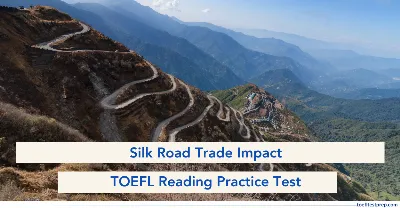Silk Road Trade Impact - TOEFL iBT® Reading Practice Test

"The Silk Road was a large network of trade routes set up during the Han Dynasty around the 2nd century BCE. Prepare for TOEFL exam with the Reading Test on ‘Silk Road Trade Impact’"
Key Highlights
The Silk Road, a network of trade routes connecting Asia, the Middle East, and Europe, played a crucial role in shaping world history by facilitating cultural, economic, and technological exchanges from around 130 BCE to the 1450s.
Beyond the trade of silk, spices, and precious goods, the Silk Road served as a channel for the exchange of ideas, religious beliefs, and innovations. Through this extensive network, societies gained access to new knowledge, technologies, and artistic influences, transforming economies and daily life across continents. This passage will explore the Silk Road’s lasting impact on global trade, cultural exchange, and historical development.
Reading Instructions:
- You have 15 minutes to read the following passage and answer all 9 questions related to it.
- Most questions are worth 1 point, but the last question is worth more. The directions indicate how many points you will receive for that specific question.
- The specific section/paragraphs have been provided again with the question for ease of understanding and quick solution.
- Some questions include a word or phrase that is highlighted in the question as well as in the paragraph for quick reference.
Silk Road Trade Impact
The Silk Road was a large network of trade routes set up during the Han Dynasty around the 2nd century BCE. It significantly affected the social, economic, and technical exchanges between civilizations across Asia, the Middle East, and Europe until the 14th century CE. Spanning about 6,500 kilometers, this complex web of pathways helped trade not only silk, spices, and precious metals. It also facilitated the exchange of ideas, religions, and new ideas. The term Silk Road was created in the 19th century, but its historical importance as a channel for commerce and social interaction has been recognized for centuries. The routes crossed various terrains, including the dry Gobi Desert, the tough Tian Shan mountains, and fertile river valleys, linking major cities like Changan (modern-day an), Samarkand, and Constantinople, which served as vital hubs for merchants and travelers.
The economic effects of the Silk Road were important, as it allowed goods to flow between regions that were previously isolated. For example, silk, which was made only in China, became a highly wanted item in the Roman Empire, symbolizing wealth and status. The growing demand for silk led to a profitable trade that helped enrich Chinese merchants and stimulated the economies of places like Persia and the Byzantine Empire. Also, the exchange of items like spices, textiles, and precious stones created a lively marketplace that attracted traders from many backgrounds. This reliance to the rise of powerful city-states and empires, as they sought to control trade routes and access valuable resources, changing the political landscape of the time.
However, the Silk Road was not just a route for material goods; it also helped exchange ideas and social practices. The spread of Buddhism from India to China is one of the most significant examples of this cultural exchange. As merchants traveled the Silk Road, they brought with them not only goods but also religious beliefs and philosophies. This exchange led to the founding of religious communities along the trade routes, which served as centers of learning and cultural sharing. Likewise, the introduction of other religions, such as Zoroastrianism and Islam, further enriched the culture of the regions connected by the Silk Road. Although the mixing of diverse cultural elements fostered a spirit of acceptance and curiosity among different peoples, it also led to conflicts, especially when differing beliefs collided.
New ideas spread along the Silk Road, significantly impacting the societies involved in trade. The sharing of knowledge about papermaking from China to the West is a prime example of how the Silk Road helped technological advancement. The introduction of paper changed record-keeping and literature in the Islamic world and later in Europe. This contributed to the spread of literacy and education. Additionally, advancements in navigation and map-making, as well as new farming techniques, were shared through the interactions of traders and scholars. These exchanges not only improved the quality of life for many but also laid the groundwork for future innovations, like the printing press, which would further change societies.
Despite its many benefits, the Silk Road faced challenges. The large distances and varied terrains created significant obstacles to trade, including the threat of banditry and political instability in different areas. The Mongol Empire, which emerged in the 13th century, played a crucial role in securing the trade routes, leading to a period of relative peace known as the Pax Mongolica. This stability helped increase trade and cultural exchange; however, it also meant that diseases, like the bubonic plague, could spread more quickly. The connection of the Silk Road ultimately contributed to the worldwide integration of trade and culture, but it also highlighted the weaknesses that come with such extensive networks, as the rapid movement of people and goods could lead to serious consequences.
In conclusion, the impact of the Silk Road on trade, culture, and technology was deep and far-reaching. It not only changed the economies of the regions it connected but also fostered a rich exchange of ideas and innovations that shaped history. The legacy of the Silk Road continues to resonate today, reminding us of the connections between human societies and the importance of social exchange. Modern global trade networks reflect the patterns established along the Silk Road, showing that the movement of goods and ideas remains a key part of human progress. As scholars continue to study the complexities of this ancient trade route, questions about its influence on todays society and its role in shaping worldwide integration remain relevant, inviting further investigation into the lessons that can be learned from this historical event.
Paragraph 1
The Silk Road was a large network of trade routes set up during the Han Dynasty around the 2nd century BCE. It significantly affected the social, economic, and
technical exchanges between civilizations across Asia, the Middle East, and Europe until the 14th century CE. Spanning about 6,500 kilometres, this complex web of pathways helped
trade not only silk, spices, and precious metals. It also facilitated the exchange of ideas, religions, and new ideas. The term Silk Road was created in the 19th century, but its historical importance as a channel for commerce and social interaction has been recognised for centuries. The routes crossed various terrains, including the dry Gobi Desert, the tough Tian Shan mountains, and fertile river valleys, linking major cities like Chang'an (modern-day Xian), Samarkand, and Constantinople, which served as vital hubs for merchants and travellers.
Factual Information Questions
- According to paragraph 1, what was one of the main purposes of the Silk Road?
- To facilitate the exchange of ideas and religions
- To establish military routes
- To promote agricultural practices
- To connect only European cities
Negative Factual Information Questions
- The author mentions all of the following as features of the Silk Road EXCEPT:
- It was established during the Han Dynasty.
- It was primarily used for military purposes.
- It connected various terrains across Asia and Europe.
- It facilitated trade in silk and spices.
Paragraph 2
The economic effects of the Silk Road were important, as it allowed goods to flow between regions that were previously isolated. For example, silk, which was made only in China, became a highly wanted item in the Roman Empire, symbolising wealth and status. The growing demand for silk led to a profitable trade that helped enrich Chinese merchants and stimulated the economies of places like Persia and the Byzantine Empire. Also, the exchange of items like spices, textiles, and precious stones created a lively marketplace that attracted traders from many backgrounds. This reliance contributed to the rise of powerful city-states and empires, as they sought to control trade routes and access valuable resources, changing the political landscape of the time.
Inference Questions
- What can be inferred from paragraph 2 about the impact of silk on the Roman Empire?
- It was considered a common item among the lower classes.
- It played a role in establishing trade relations with China.
- It was primarily used for military uniforms.
- It had little effect on the economy of the Roman Empire.
Rhetorical Purpose Questions
- Why does the author mention the rise of powerful city-states and empires in paragraph
2?- To illustrate the political instability caused by trade
- To highlight the economic benefits of the Silk Road
- To discuss the military conflicts that arose from trade
- To emphasise the cultural exchanges that occurred
Paragraph 3
However, the Silk Road was not just a route for material goods; it also helped exchange ideas and social practices. The spread of Buddhism from India to
China is one of the most significant examples of this cultural exchange. As merchants travelled the Silk Road, they brought with them not only goods but also religious beliefs and
philosophies. This exchange led to the founding of religious communities along the trade routes, which served as centres of learning and cultural sharing. Likewise, the introduction
of other religions, such as Zoroastrianism and Islam, further enriched the culture of the regions connected by the Silk Road. Although the mixing of diverse cultural elementsfostered a spirit of acceptance and curiosity among different peoples, it also led to conflicts, especially when differing beliefs collided.
Vocabulary Questions
- The word "significant" in paragraph 3 is closest in meaning to:
- Unimportant
- Notable
- Obscure
- Minor
Sentence Simplification Questions
- Which of the sentences below best expresses the essential information in the following text in paragraph 3?
"The spread of Buddhism from India to China is one of the most significant examples of this cultural exchange."
- Buddhism was the only religion to spread along the Silk Road.
- Buddhism's spread from India to China exemplifies cultural exchange.
- Cultural exchange was limited to religious beliefs.
- The Silk Road was primarily a trade route for Buddhism.
Paragraph 4
New ideas spread along the Silk Road, significantly impacting the societies involved in trade. The sharing of knowledge about papermaking from China to the West is a prime example of how the Silk Road helped technological advancement. The introduction of paper changed record-keeping and literature in the Islamic world and later in Europe. This contributed to the spread of literacy and education. Additionally, advancements in navigation and map-making, as well as new farming techniques, were shared through the interactions of traders and scholars. These exchanges not only improved the quality of life for many but also laid the groundwork for future innovations, like the printing press, which would further change societies.
Purpose of the Passage Questions
- What is the main purpose of paragraph 4?
- To discuss the challenges faced by traders on the Silk Road
- To highlight the technological advancements facilitated by the Silk Road
- To explain the cultural conflicts that arose from trade
- To describe the geographical features of the Silk Road
Paragraph 5
Despite its many benefits, the Silk Road faced challenges. The large distances and varied terrains created significant obstacles to trade, including the threat of banditry and political instability in different areas. The Mongol Empire, which emerged in the 13th century, played a crucial role in securing the trade routes, leading to a period of relative peace known as the Pax Mongolica. This stability helped increase trade and cultural exchange; however, it also meant that diseases, like the bubonic plague, could spread more quickly. The connection of the Silk Road ultimately contributed to the worldwide integration of trade and culture, but it also highlighted the weaknesses that come with such extensive networks, as the rapid movement of people and goods could lead to serious consequences.
Insert Missing Sentence Question
"Despite these challenges, the Silk Road remained a vital artery for commerce."
- Where would the sentence best fit?
(A) Despite its many benefits, the Silk Road faced challenges. (B) The large distances and varied terrains created significant obstacles to trade, including the threat of banditry and political instability in different areas. (C) The Mongol Empire, which emerged in the 13th century, played a crucial role in securing the trade routes, leading to a period of relative peace known as the Pax Mongolica. (D)
Prose Summary Questions
Directions: An introductory sentence for a brief summary of the passage is provided below. Complete the summary by selecting the THREE answer choices that express the most
important ideas in the passage. Some sentences do not belong in the summary because they express ideas that are not presented in the passage or are minor ideas in the passage. This question is worth 2 points.
- The Silk Road was a crucial network of trade routes that connected various regions and cultures.
- It facilitated the exchange of goods, ideas, and technologies across continents.
- The Silk Road was primarily used for military purposes.
- It contributed to the rise of powerful empires and city-states.
- The Silk Road faced numerous challenges, including banditry and disease.
- It was established during the Roman Empire and primarily served European interests
Answer Key with Explanation for TOEFL Reading Passage - Silk Road Trade Impact
1. Answer: A
Explanation: The passage clearly states that the Silk Road significantly affected social, economic, and technical exchanges, including the exchange of ideas and religions. While it
was also a trade route for goods, the emphasis on the exchange of ideas indicates that this was a primary purpose.
2. Answer: B
Explanation: The passage discusses the Silk Road's role in trade and cultural exchange, but it does not mention military purposes. Instead, it highlights its significance in commerce
and social interaction, making option B the correct choice as it is not supported by the text.
3. Answer: B
Explanation: The passage notes that silk was a highly desired item in the Roman Empire, indicating that it was significant in establishing and enhancing trade relations with
China. This suggests that silk was not just a luxury item but also a catalyst for broader economic interactions.
4. Answer: B
Explanation: The author discusses how the Silk Road stimulated economies and contributed to the rise of powerful city-states and empires. This illustrates the economic benefits derived from the trade routes, making option B the most relevant choice.
5. Answer: B
Explanation: In the context of the passage, "significant" refers to something that is important or noteworthy. "Notable" conveys a similar meaning, while the other options suggest the opposite or a lesser degree of importance.
6. Answer: B
Explanation: This option accurately captures the essence of the original sentence by summarising the key point that the spread of Buddhism is a prime example of cultural exchange along the Silk Road, without introducing inaccuracies or limiting the scope.
7. Answer: B
Explanation: The paragraph focuses on how new ideas and technologies, such as papermaking and advancements in navigation, spread along the Silk Road. This indicates that the primary purpose is to showcase the technological impacts of the trade routes.
8. Answer: A
Explanation: The missing sentence serves as a transition that acknowledges the challenges faced by the Silk Road while also affirming its importance. Placing it at the beginning of the paragraph sets the stage for discussing the obstacles that follow.
9. Answer: A, C, and D
Explanation: These three choices encapsulate the main ideas of the passage: the exchange facilitated by the Silk Road, its economic impact on empires, and the challenges it faced. Options B and E do not accurately reflect the content of the passage.
Also Read:
- New Language - TOEFL Speaking Independent Practice Test Paper with Responses
- Serengeti Herbivores - TOEFL Reading Practice Test Paper with Answers
- The Easter Island - TOEFL Reading Practice Questions with Answer Key
- Theory of Evolution - TOEFL Reading Practice Test with Answer Key
- Microplastics - TOEFL iBT® Reading Practice Test with Answer Key
Featured Articles

Marriage Across Cultures - TOEFL Reading Practice Test
Improve TOEFL Reading with passages on 'Marriage Across Cultures,' delving into unique traditions, values, and global perspectives on marriage.
July 15, 2025
Writing Center Services - TOEFL Speaking Practice Test with Answers (Integrated)
Prepare for the TOEFL Integrated Speaking section with a practice test on 'Writing Center Services' and learn to improve score in TOEFL exam.
July 15, 2025
Tutorial Room Booking - TOEFL Speaking Practice Test with Answers (Integrated)
Prepare for the TOEFL Integrated Speaking section with a practice test on 'Tutorial Room Booking ' and learn to improve score in TOEFL exam.
July 15, 2025
Textbook Rental System - TOEFL Speaking Practice Test with Answers (Integrated)
Prepare for the TOEFL Integrated Speaking section with a practice test on 'Textbook Rental System' and learn to improve score in TOEFL exam.
July 15, 2025